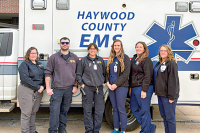Books are an end unto themselves
Books are one of the greatest delights of my life. I don’t need many excuses to buy new ones, frankly, but when I do feel the situation is spinning out of control (my third trip in a week, say, to the Friends of the Library bookstore in Sylva), my book-buying ways are justified as “building a research library.”
While I openly admit to self-deception on this score, there is a strong argument to be made for owning a good selection of reference books. The Internet is a wonderful tool, but it doesn’t replace owning books — the information nicely supplements them.
Last week, while ostensibly on assignment interrogating Ryan Sherby of the Southwestern Development Commission for a couple of transportation-related news articles, our conversation soon wandered off into much more interesting territory: vegetable gardening.
Sherby, who lives in the Alarka community in Swain County, has turned the earth and prepared the soil for a Very Big Garden this year. I farmed for a time in Bryson City before moving to Sylva, so it seemed entirely natural to segue from road building (b-o-r-i-n-g) to discussions about much more vital issues, such as planting dates, vegetable varieties and so on (endlessly riveting). I’ve promised to unearth my seed-starting calendar and email it to him.
Ryan’s and my discussion led me into a consideration of the books I rely on as a vegetable gardener. These books are as well used as my favorite hoe, and as important to my growth as nitrogen is for the growth of plants.
That said, here’s a few of my favorites:
Related Items
• Four-Season Harvest, Eliot Coleman: A Maine organic farmer who has led the charge for growing yearlong. His books — there’s others, all of them worth owning — form the basis of my approach to gardening, which I’d sum up with the truism, feed the soil and not the plant. Coleman’s other books are: The New Organic Grower and The Winter Harvest Handbook.
• The New Seed Starter’s Handbook, Nancy Bubel: Everything you need to know for growing your own transplants, and more. This is an excellent go-to reference that should be on every gardener’s bookshelf. I learned a lot from this book about the importance of soil temperature when it comes to germination rates. In fact, Bubel’s book inspired me to purchase a soil thermometer, which if I could locate said thermometer would, I’m sure, prove very useful and interesting.
• Root Cellaring, Mike and Nancy Bubel: As the title indicates, this book is about building and using a root cellar. That’s handy, but also tucked inside is a terrific little growing section on vegetables that keep particularly well in the root cellar.
• The Vegetable Gardener’s Bible, Edward C. Smith: the subtitle is “Discover Ed’s High-Yield W-O-R-D System for All North American Gardening Regions,” which has a breathless irritating quality that is repeated in places throughout the book. But if you can overlook the over-hyping of his method — which is simply using wide rows, organic techniques and so on, sound gardening methods but not exactly revolutionary — this is a fine guide. Like so many of the good vegetable gardening books, this is geared for the northern part of the nation, so you have to tweak information for the Southeast. I loaned my copy out and haven’t seen it since, a reminder to me not to make loans, only gifts.
• The Essential Earthman, and anything else written by Henry Mitchell. This book is adopted from Mitchell’s “Earthman” column in the Washington Post. He died in 1993, but not before penning some of the most delightful, witty words every written in America on gardening. Many of his columns are on flowers and not vegetables, but that’s a petty point. Flowers are plants, too, are they not? And some flowers are even edible. Anyhow, buy and read Mitchell. You won’t be sorry.
(Quintin Ellison can be reached at This email address is being protected from spambots. You need JavaScript enabled to view it..)









